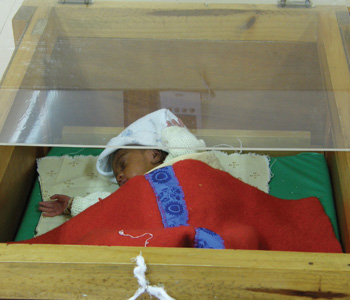Viewpoint
Optics and Photonics for the Developing World
Rebecca Richards-Kortum and Jennifer Carns discuss how new light technologies could improve health care in low-resource settings.
 A hot cot in use at Queen Elizabeth Central Hospital, Malawi. [Deb Niemeier/UC Davis]
A hot cot in use at Queen Elizabeth Central Hospital, Malawi. [Deb Niemeier/UC Davis]
Advances in photonic technologies have led to significant improvements in health care; immunofluorescence microscopy, optical coherence tomography and fluorescence-activated cell sorting are all a routine part of medicine in high-resource settings such as the United States. With the low cost and low power consumption of many photonic technologies, it seems that they could also improve health care in low-resource settings, such as sub-Saharan Africa. However, a comparison of the per capita health care expenditures in the United States (over US$8,000) and Malawi (US$74) as reported by the World Health Organization gives an indication of the vast difference in resources available for health care between the two countries.
…Log in or become a member to view the full text of this article.
This article may be available for purchase via the search at Optica Publishing Group.
Optica Members get the full text of Optics & Photonics News, plus a variety of other member benefits.
